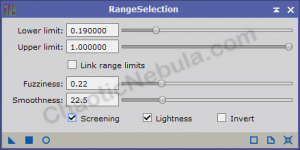Range masks are another easy and common type of mask to use in that it allows you to adjust brightness levels for mask protection. In order for this to work, the initial image must be non-linear (stretched).



Range masks are most often used in the later stages of image processing where we need to focus our attention on sharpening, color and brightness adjustments on the brighter areas of the image or on helping to darken the background.
Range Mask
To create a range mask effectively, use the real-time preview option so you can see how the changes will impact the created range mask.
The main things you will need to change are:
- Lower Limit: This adjusts the how much of the low signal areas (dark parts) you wish to incorporate within the mask. In most cases, this will move higher to focus attention of the brightest parts.
- Fuzziness: Determines how sharp of a transition there will be between protected/unprotected portions of the image. This is often increased to create a smoother transition
- Smoothness: This determines how much of a blur to apply to the mask.
- Screening: The screening option helps create a mask that has intensity levels aligned with the initial image. This is similar to what a luminance mask would do. This is typically not used very often.
- Lightness: Focuses the mask on the luminance portion of the image. This is typically enabled.



